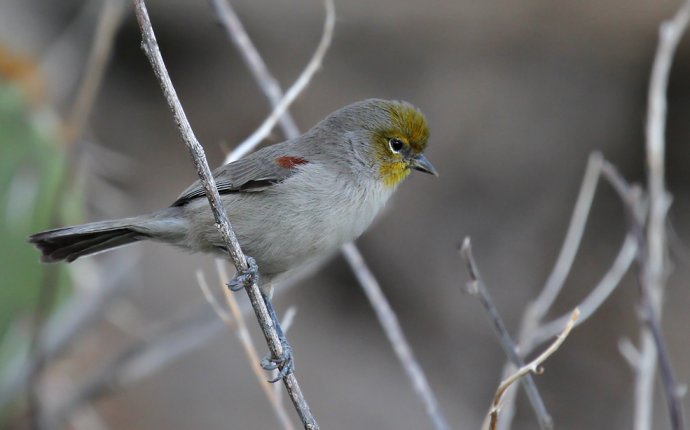
Small Birds of Arizona
 Common Birds in Tucson
Common Birds in Tucson
Anna’s Hummingbird
Any hummingbird feeder in urban Tucson probably has a resident Anna’s Hummingbird defending it from all intruders. This beautiful and large hummer is a common sight in backyards across the city and the male’s striking rosy-pink flashing head plumage makes it a compelling reason to keep your feeders full of nectar. In the first half of the last century this bird’s breeding range was limited to southwestern California. As the century progressed parks were created and gardens were planted and the birds steadily expanded their range north into Oregon and east into southern Arizona. Some Anna’s Hummingbirds live in Tucson year-round but from December to May their numbers increase as birds come to urban Tucson to nest and take advantage of the abundant flowers and feeders our yards provide. This time of year you may also witness the spectacular courtship display of the male Anna’s Hummingbird right in your yard. The male flies to a high point above an available female and then dives straight down and suddenly pulls up right over her with an explosive popping sound (caused by air passing at just the right velocity over special feathers in the tail). It is an amazing thing to witness and happens all over Tucson all winter and early spring.
The male flies to a high point above an available female and then dives straight down and suddenly pulls up right over her with an explosive popping sound (caused by air passing at just the right velocity over special feathers in the tail). It is an amazing thing to witness and happens all over Tucson all winter and early spring.
– Jennie MacFarland, IBA Conservation Biologist
Cooper’s Hawk
The Cooper’s Hawk (Accipiter cooperii) is a common year-round resident in Tucson. This medium-sized hawk has a long tail and gray back, and adults have a salmon-colored breast (hawks in their first year of life have a white breast with brown streaks). Although common in Tucson, the Cooper’s Hawk is not especially conspicuous in January, unless you are lucky and have one visiting your yard to hunt for doves and other small birds. Cooper’s Hawks clearly know the yards where people feed birds, and take advantage of the concentration of prey. In February, the nesting cycle begins anew, and Cooper’s Hawks become easy to see, especially early in the morning, when both males and females participate in courtship flights and nest building activities. They also vocalize (kek-kek-kek-kek) regularly during this time of year. Cooper’s Hawks typically build their nests in relatively large trees (Eucalyptus or pine) and occupy many of the parks, golf courses, cemeteries, and apartment complexes throughout Tucson. Next time you are out birding, don’t forget to listen for their calls, and look on the ground under groves of large trees for piles of bird feathers, and streaks of “white-wash”—tell tale signs of their presence.
Although common in Tucson, the Cooper’s Hawk is not especially conspicuous in January, unless you are lucky and have one visiting your yard to hunt for doves and other small birds. Cooper’s Hawks clearly know the yards where people feed birds, and take advantage of the concentration of prey. In February, the nesting cycle begins anew, and Cooper’s Hawks become easy to see, especially early in the morning, when both males and females participate in courtship flights and nest building activities. They also vocalize (kek-kek-kek-kek) regularly during this time of year. Cooper’s Hawks typically build their nests in relatively large trees (Eucalyptus or pine) and occupy many of the parks, golf courses, cemeteries, and apartment complexes throughout Tucson. Next time you are out birding, don’t forget to listen for their calls, and look on the ground under groves of large trees for piles of bird feathers, and streaks of “white-wash”—tell tale signs of their presence.
-Bill Mannan, Professor of Wildlife Ecology, University of Arizona, and specialist in urban raptors
Gambel’s Quail
I brake for quail. I just can’t resist stopping to watch the cartoonish meanderings of a troupe of Gambel’s Quail, scurrying across the road or poking around in the desert scrub. There is safety in numbers, and these gregarious birds will often travel in a large group called a covey. Sprinting away from threats (at speeds around 20 feet per second) is the preferred method of escape, though they can fly short distances.













